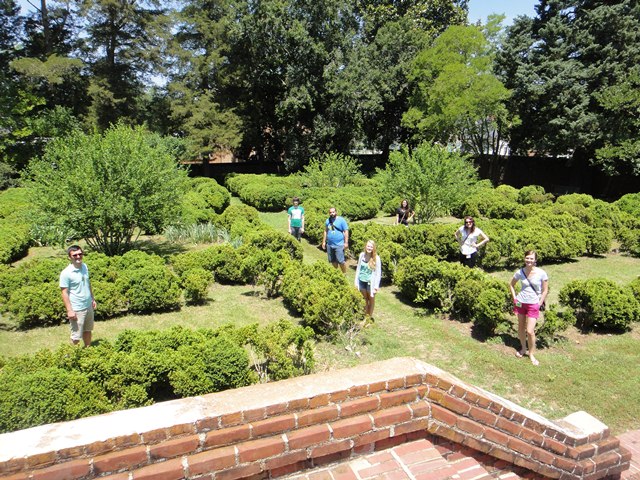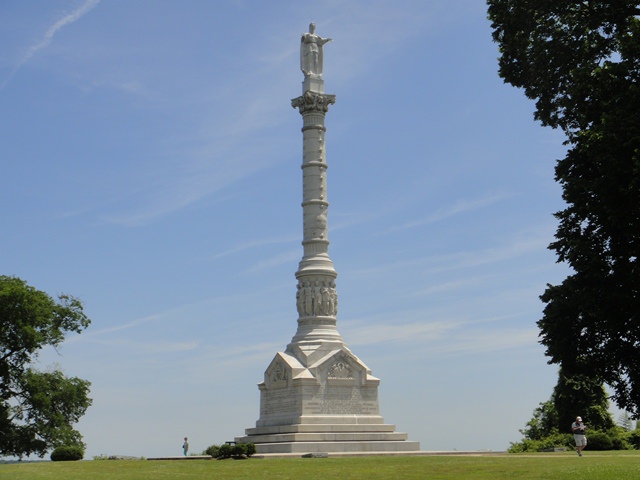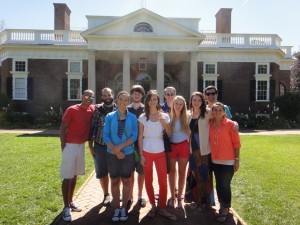 Our tour of historic southeastern Virginia continues. Tuesday was a full day at Monticello, Thomas Jefferson’s home. I’ve been to Monticello numerous times, but every time I learn more. Particularly interesting was the interpreter’s talk about slavery at the plantation. He interspersed the overall picture with vignettes from the lives of various slaves who labored there. There were three levels of slavery at the plantation: farm workers; artisans/craftsmen; house servants. One family—the Hemings—was almost slave royalty, resented by those who didn’t get the same privileges. If the name Hemings sounds familiar, it’s because Jefferson might have been the father of a number of those children via Sally Hemings.
Our tour of historic southeastern Virginia continues. Tuesday was a full day at Monticello, Thomas Jefferson’s home. I’ve been to Monticello numerous times, but every time I learn more. Particularly interesting was the interpreter’s talk about slavery at the plantation. He interspersed the overall picture with vignettes from the lives of various slaves who labored there. There were three levels of slavery at the plantation: farm workers; artisans/craftsmen; house servants. One family—the Hemings—was almost slave royalty, resented by those who didn’t get the same privileges. If the name Hemings sounds familiar, it’s because Jefferson might have been the father of a number of those children via Sally Hemings.
Jefferson was a complex man in some ways, engaged in the world of politics but liking nothing better than to experiment with various plants and garden seeds. He also was fascinated with architecture, and never really completed his vision for what Monticello should be.
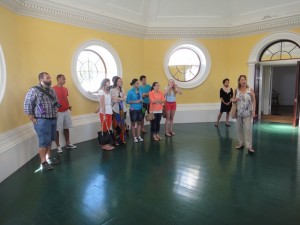 In all my previous trips to the house, I just took the basic tour, but this time we had a more extensive tour that took us into the upper levels, even to the famous dome on the top. It was nice to be part of a smaller group for this special peek into areas where tourists normally don’t go. Yet for all Jefferson’s ingenuity, there is an incompleteness to the house that you can feel. He was never satisfied.
In all my previous trips to the house, I just took the basic tour, but this time we had a more extensive tour that took us into the upper levels, even to the famous dome on the top. It was nice to be part of a smaller group for this special peek into areas where tourists normally don’t go. Yet for all Jefferson’s ingenuity, there is an incompleteness to the house that you can feel. He was never satisfied.
Historians like to talk about how brilliant he was, but he certainly didn’t come to a brilliant conclusion in his religious beliefs. I was able to peruse his version of the gospels at the bookstore, and it was exactly as I have often taught: the supernatural is omitted, and it ends with Jesus being laid in the grave. There is no resurrection account.
Jefferson wanted people to follow the morals of the Bible, but not the One who established those morals from eternity.
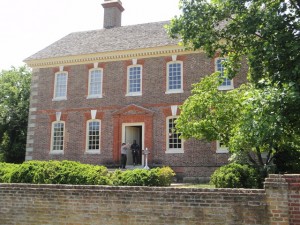 Yesterday was Yorktown day, scene of the final major battle of the American Revolution. We didn’t have time to drive around the battlefield itself, although I would like to do so sometime since I’m now more focused on those details than before—I now teach an upper-level course on the era. That will have to wait for another time. One of our stops, though, was the Thomas Nelson house in historic Yorktown. Nelson was governor of Virginia at the time of the Battle of Yorktown in September-October 1781. The town was occupied by the British under Gen. Cornwallis. There’s some evidence that Nelson’s house may have served as the headquarters for the general.
Yesterday was Yorktown day, scene of the final major battle of the American Revolution. We didn’t have time to drive around the battlefield itself, although I would like to do so sometime since I’m now more focused on those details than before—I now teach an upper-level course on the era. That will have to wait for another time. One of our stops, though, was the Thomas Nelson house in historic Yorktown. Nelson was governor of Virginia at the time of the Battle of Yorktown in September-October 1781. The town was occupied by the British under Gen. Cornwallis. There’s some evidence that Nelson’s house may have served as the headquarters for the general.
Nelson was at the battle, but outside the town as part of the besieging army. He is said to have told Washington not to spare even his own home if it would mean the surrender of the British troops. I’m not sure that bit of information is adequately documented, but it does apparently showcase Nelson’s attitude and his commitment to the cause.
While we were there, I thought I’d get a good picture of some of my traveling companions in Nelson’s garden. Nothing historic in this photo, but I just thought it was a neat picture:
On the edge of the historic district is the monument commemorating the victory.
Although the standard name for this war always has been the American Revolution—and I have to use that name so people will know what I’m talking about—I tell students that a more accurate name would be The American War for Continued Self-government. You see, in this “revolution” the “haves” were the leading figures, not the “have-nots.” They weren’t trying to uproot a system; they hoped to salvage the good in it. They had governed themselves for many decades, and the British government changed the status quo. If you really want to see the revolutionaries of the period, look three thousand miles across the Atlantic. The united colonies, which became the United States, achieved their original aim: self-government was established once again.

